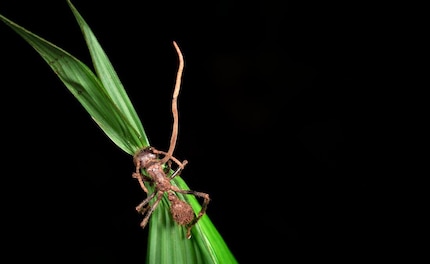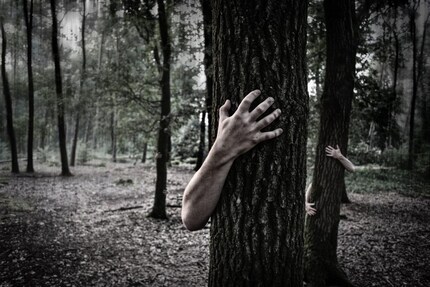
Background information
The Queen's Gambit: what’s up with all the green pills?
by Dominik Bärlocher


The undead are coming. «The Walking Dead» has been dragging itself along on Sky and co. for nearly ten seasons now. Time to take a look at some real-world specimens.
Zombies have become essential to pop culture. Countless books, movies and TV series such as «The Walking Dead», based on the comics of the same name by Robert Kirkman, use this trope. But are there really cases of zombie-like infections in real life?
The word zombie – originally zombi – first appeared in English during the 19th century, when poet Robert Southey mentioned it in his history of Brazil.
According to the Merriam Webster dictionary, the name originates from the Louisiana or Haitian Creole word «zonbi», a relative of the African Kimbundu phrase «nzúmbe», meaning ghost. The word refers to creatures from Haitian folklore, originally nothing more than ghosts similar to those in western tales.
Its concept, however, was warped through time, referring to a person controlled by a witch doctor. The victim enters a near-death state, becoming a puppet for the witch doctor to master. These days we inflate the meaning of «zombie», metaphorically using it to talk about someone apathetic, slow-moving or with little regard for their surroundings. So anyone with a smartphone, basically.
Still, could there really be creatures similar to zombies surrounding us? And if yes, what are they and how do they achieve this state of «undeath»?
Ophiocordyceps is a fungus genus with more than 200 species. Many species of fungi can be dangerous, as they are often toxic to animals. There is one slightly terrifying fact about Ophiocordyceps, however.

Their fungal spores can infect various insects. After infection, the parasitic fungus takes control of the insect's mind and changes its behaviour to make the spread of fungal spores more likely. Ophiocordyceps feeds on insects. They attach themselves, grow into and out of their body until the host dies.
One of these fungi, Ophiocordyceps unilateralis sensu lato, specifically infects and kills North American carpenter ants (Camponotus castaneus). When the fungus infects the ant, it turns into a zombie. The ant is forced to climb to the top of elevated vegetation where it remains and dies. Thanks to the elevation, the mushroom can spread its spores far. Researchers at Pennsylvania State University found that O. unilateralis takes full control of the muscle fibres of ants and forces them to move as it commands.
«We found out that a high percentage of the cells in a host were fungal cells,» says David Hughes, associate professor of entomology and biology at Penn State. Essentially, these manipulated animals are mushrooms in an ant's coat, Hughes continued.
Zoologist Philippe Fernandez-Fournier from the University of British Columbia in Vancouver and his colleagues made an extraordinary discovery in the Ecuadorian Amazon last year.

They found out that a previously unknown species of the Zatypota wasp can manipulate spiders of the species Anelosimus eximius to an extent that researchers in nature have never observed before.
A.eximius spiders are social animals that prefer to stay in groups and never stray too far away from their colonies. However, Fernandez-Fournier and his team found that members of this species infected with Zatypota larvae exhibited bizarre behaviour, weaving tight cocoon-like nets in remote locations.
When researchers opened these artificial cocoons, they found growing Zatypota larvae inside. The wasps lay their eggs on the belly of A.eximius spiders. When the wasp larva hatches, it begins to feed on the spider and take control of its body. Once the larva has gained full control over its host, it turns into a zombie-like creature, forced to distance itself from its companions and spin its cocoon-like nest in which the larva grows into an adult wasp.
«Wasps that manipulate the behaviour of spiders have been observed before, but not at such a complex level,» says Fernandez-Fournier. The change in behaviour of the spider is extreme. The wasp completely takes over the brain and thus also the behaviour of the spider, causing it to do something extraordinary. Such as leaving its nest or spinning a completely different structure.
The revival of humans, or at least human-like creatures, as in Mary Shelley's Frankenstein is a subject that has always aroused the interest of writers, filmmakers and, of course, scientists.

While awakening the dead isn't (yet) an option to us, the resuscitation of other organisms is possible. This can be particularly disturbing when these organisms are viruses. In 2014, researchers at the National Research Centre of the University of Aix-Marseille in France unearthed a fascinating organism from the Siberian permafrost: a 30,000 year old so-called giant virus, which they called Pithovirus sibericum.
Huge viruses are so called because they are still tiny but easily visible under a microscope. There's something else that sets P.sibericum apart: it's a DNA virus that contains a large number of genes, up to 500.
This is in contrast to other DNA viruses such as the human immunodeficiency virus (HIV), which contains only about twelve genes.
The size of giant viruses and the fact that they contain so much DNA can make them particularly dangerous. «Among known viruses, giant viruses are usually very tough and can hardly be broken open,» two of the virus's discoverers, Jean-Michel Claverie and Chantal Abergel, explained in an interview with National Geographic. «Special environments such as deep sea sediments and permafrost protect microbes and viruses very well because they are cold, oxygen-free and dark,» they add.
P. sibericum infects only amoebae, archaic unicellular organisms, fortunately avoiding humans or other animals. Nevertheless, Claverie and Abergel warn that similar giant viruses may be buried in permafrost, which could prove to be dangerous to humans. They could reappear and come to life through global warming and human activity. Mining and drilling meant unearthing these ancient layers for the first time in millions of years.
In 2014, researchers at the John Innes Centre in Norwich, UK, found that certain bacteria known as phytoplasma transform some plants into zombies.

The bacteria spread by insects infect plants such as goldenrods that have yellow flowers. The infection causes goldenrods to sprout leaf-like extensions instead of their usual flowers. These leaf-like growths attract more insects, allowing bacteria to travel and infect other plants.
While the transformation doesn't lead to the death of the plant, the researchers are fascinated by how phytoplasma can influence the will of its host. «The insects transmit bacteria, so-called phytoplasms, which destroy the life cycle of plants,» says Professor Günter Theissen from the Friedrich Schiller University in Jena, one of the researchers who has investigated the activity of phytoplasma in detail. These plants become living dead. After all, they only serve to spread the bacteria, Theissen continued.
Can humans also turn into zombies? In the 1990s, researchers decided to investigate this. In 1997, Doctor Chavannes Douyon and Professor Roland Littlewood published a study in The Lancet. They analyzed cases of three people from Haiti whose communities had identified them as zombies.

One was a 30-year-old woman who allegedly died quickly after falling ill. Her family recognised her as a «zombie» three years after this event. Another was a young man who had died at the age of 18 and reappeared after another 18 years at a cockfight. The last case study concerned another woman who died at the age of 18 but returned as a zombie 13 years after this event.
Dr. Douyon and Prof. Littlewood examined the three «zombies» and found that they were not victims of an evil spell. Instead, medical reasons could explain their zombification. The first woman had catatonic schizophrenia, a rare disease that causes the person to behave as if they were walking while under anaesthesia. The second person had brain damage and epilepsy, while the third seemed to only have a learning disability.
«People with chronic schizophrenic diseases, brain damage or learning disabilities aren't uncommon in Haiti and it's likely that they lack the will and memory characteristic of a zombie,» the researchers write in their article.
But there's also a specific mental disorder called Cotard Syndrome that can cause people to behave like zombies. This is because they are under the impression of being dead or decomposing. It remains unclear how widespread this disease is, but research suggests that it is a rare event. Documented cases of people with Cotard syndrome are nevertheless worrying.
A case study reports the situation of a 53-year-old woman who complained that she was dead, smelled of rotten meat, and wanted to be taken to a morgue to be with dead people. Another source mentions a 65-year-old man who believed his organs, including his brain, had stopped working. Even the house where he lived was slowly but surely falling apart. At some point, the man tried to take his own life. Researchers report that he wrote in a suicide note that he wanted to kill himself because he feared to transmit a deadly infection to other villagers.
I'm sure you're asking what all this has to do with Digitec Galaxus? Good question. After all, we neither sell zombie ants nor giant viruses in our shop (as of writing). I didn't even want to write this article. But a voice in my head made me do it. Sorry. More brainless texts from me can be found here. Drag over your mindless husk and become my willing follower.


From radio journalist to product tester and storyteller, jogger to gravel bike novice and fitness enthusiast with barbells and dumbbells. I'm excited to see where the journey'll take me next.